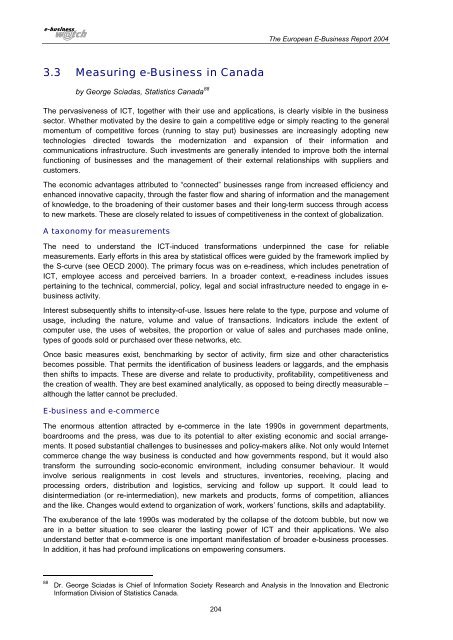The European e-Business Report 2004 - Berlecon Research GmbH
The European e-Business Report 2004 - Berlecon Research GmbH
The European e-Business Report 2004 - Berlecon Research GmbH
Create successful ePaper yourself
Turn your PDF publications into a flip-book with our unique Google optimized e-Paper software.
<strong>The</strong> <strong>European</strong> E-<strong>Business</strong> <strong>Report</strong> <strong>2004</strong>3.3 Measuring e-<strong>Business</strong> in Canadaby George Sciadas, Statistics Canada 88<strong>The</strong> pervasiveness of ICT, together with their use and applications, is clearly visible in the businesssector. Whether motivated by the desire to gain a competitive edge or simply reacting to the generalmomentum of competitive forces (running to stay put) businesses are increasingly adopting newtechnologies directed towards the modernization and expansion of their information andcommunications infrastructure. Such investments are generally intended to improve both the internalfunctioning of businesses and the management of their external relationships with suppliers andcustomers.<strong>The</strong> economic advantages attributed to “connected” businesses range from increased efficiency andenhanced innovative capacity, through the faster flow and sharing of information and the managementof knowledge, to the broadening of their customer bases and their long-term success through accessto new markets. <strong>The</strong>se are closely related to issues of competitiveness in the context of globalization.A taxonomy for measurements<strong>The</strong> need to understand the ICT-induced transformations underpinned the case for reliablemeasurements. Early efforts in this area by statistical offices were guided by the framework implied bythe S-curve (see OECD 2000). <strong>The</strong> primary focus was on e-readiness, which includes penetration ofICT, employee access and perceived barriers. In a broader context, e-readiness includes issuespertaining to the technical, commercial, policy, legal and social infrastructure needed to engage in e-business activity.Interest subsequently shifts to intensity-of-use. Issues here relate to the type, purpose and volume ofusage, including the nature, volume and value of transactions. Indicators include the extent ofcomputer use, the uses of websites, the proportion or value of sales and purchases made online,types of goods sold or purchased over these networks, etc.Once basic measures exist, benchmarking by sector of activity, firm size and other characteristicsbecomes possible. That permits the identification of business leaders or laggards, and the emphasisthen shifts to impacts. <strong>The</strong>se are diverse and relate to productivity, profitability, competitiveness andthe creation of wealth. <strong>The</strong>y are best examined analytically, as opposed to being directly measurable –although the latter cannot be precluded.E-business and e-commerce<strong>The</strong> enormous attention attracted by e-commerce in the late 1990s in government departments,boardrooms and the press, was due to its potential to alter existing economic and social arrangements.It posed substantial challenges to businesses and policy-makers alike. Not only would Internetcommerce change the way business is conducted and how governments respond, but it would alsotransform the surrounding socio-economic environment, including consumer behaviour. It wouldinvolve serious realignments in cost levels and structures, inventories, receiving, placing andprocessing orders, distribution and logistics, servicing and follow up support. It could lead todisintermediation (or re-intermediation), new markets and products, forms of competition, alliancesand the like. Changes would extend to organization of work, workers’functions, skills and adaptability.<strong>The</strong> exuberance of the late 1990s was moderated by the collapse of the dotcom bubble, but now weare in a better situation to see clearer the lasting power of ICT and their applications. We alsounderstand better that e-commerce is one important manifestation of broader e-business processes.In addition, it has had profound implications on empowering consumers.88Dr. George Sciadas is Chief of Information Society <strong>Research</strong> and Analysis in the Innovation and ElectronicInformation Division of Statistics Canada.204
















